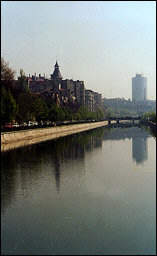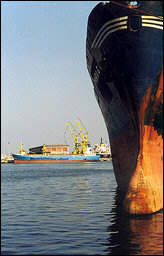 HYDROGRAPHY HYDROGRAPHY |

The Danube shapes Romania. It has been its natural division from the Ottoman Empire. Today it is widely used for transportation between the Black Sea and Central Europe. The Danube collects most of the inland river waters. At its entrance to Romania the Danube has an average flow of 5,560 m3/sec. It is precisely at that particular spot that the largest hydropower station in Europe has been erected. Throughout the Romanian territory the Danube has a course of 1,075 km and a flow of 6470 m3/sec. Other lesser rivers traverse Romania, a number of them originating in the Carpathian Range.
Lakes cover only 1.1% of the total territory.
The largest lakes are located alongside the Black
Sea (lake Razim being the largest with its 415 sq.
km). A number of barrages are located thoughout
Romania. In the highest mountains the glacial lakes
phenomena of can be found. One example of that is
Lake Balea. |
The Black Sea has a total surface of 462,535 sq. km. There are no vertical currents, which otherwise would prevent the air to penetrate the deep side of the sea. Its waters have two different inside layers. The higher layer is sweeter and measures 180m, that is where fauna is present. The inferior layer has a salinity of 22% and contains toxic gases.

In 1984 was opened to traffic the 64,2 Km long
Danube-Black Sea Canal between Cernavoda and
Agigea-Constanta. In 1992 the Rhine-Main-Danube
Canal was inaugurated facilitating a direct connection
with the North Sea. It is navigable for river and
sea-going ships of up to 5,000 dwt. |

